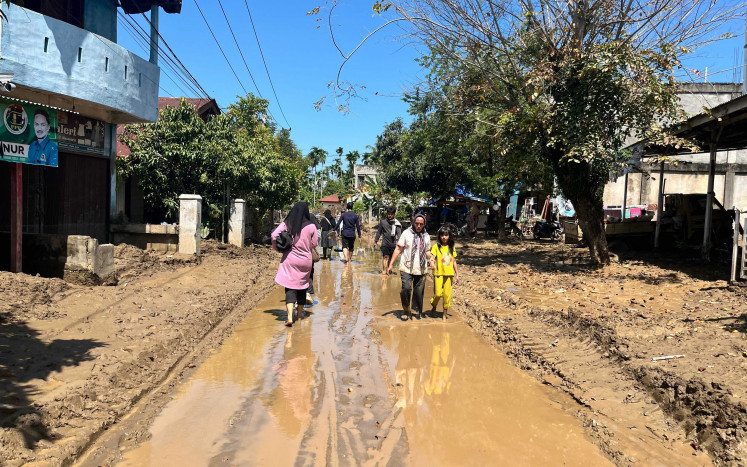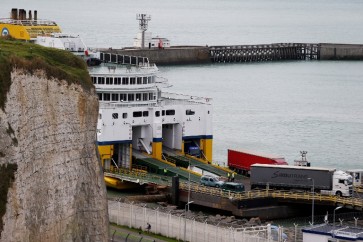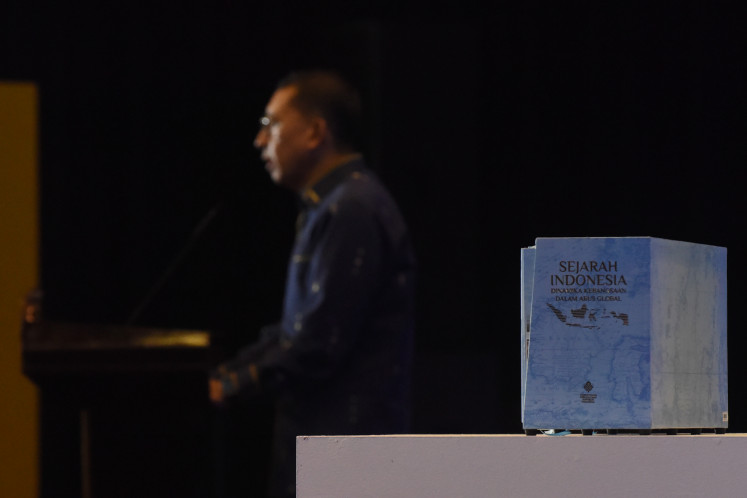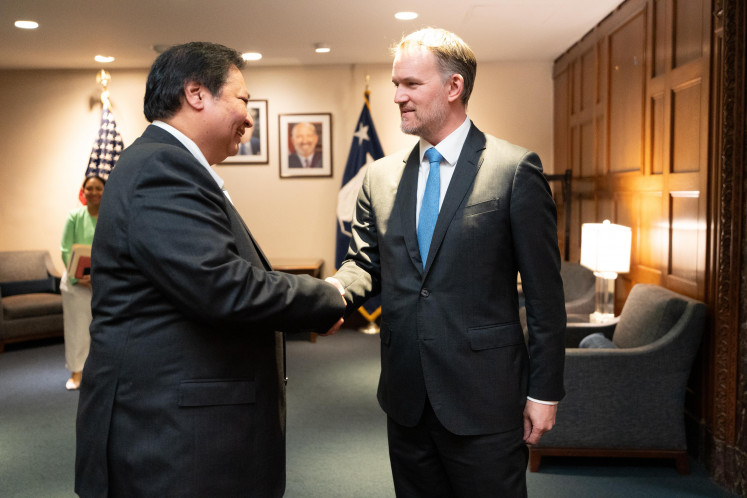Popular Reads
Top Results
Can't find what you're looking for?
View all search resultsPopular Reads
Top Results
Can't find what you're looking for?
View all search resultsThe Year in Art: Surviving the Test of Time
The classic: Battle between a Young Javanese Rhinoceros and Two Tigers by Raden Saleh gets high auction price in November this year
Change text size
Gift Premium Articles
to Anyone
T
span class="caption">The classic: Battle between a Young Javanese Rhinoceros and Two Tigers by Raden Saleh gets high auction price in November this year. Courtesy of Van Nam.com
The country's art scene continues to fuel curiosity throughout the year as it struggles to survive past controversy while welcoming fresh works by young and veteran artists alike.
Many young artists presented their works at medium and small exhibitions, sometimes in alternative spaces like cafes or pop-up events, a development that has gained support from social media that caters to visuals, like Instagram and Pinterest.
These artists diligently explored new possibilities ' producing installations, photography and video works. Most of them are no longer solely interested in painting and if they are, the media is not canvas but new material, like cardboard, resin and aluminum.
Their choice of media, theme and making processes were largely influenced by global art trends, mainly those presented at international art fairs and museums abroad that they frequently visited.
'If they do highlight the problems faced by Indonesia, they have been processed into universal or global themes. When they touch on the problems of waste, forest destruction or other such issues, it reflects not just Indonesia's problem but a global problem,' said art collector Syakieb Sungkar, who started buying art in 1995 and currently has more than 500 artworks in his collection.
On art knowledge or the academic side, however, developments have been limited ' with the amount of fine art research not matching the progress in exhibitions and art fairs, something that may become detrimental to art growth in the long run.
'I think the key to what we need to work on is to prepare for what is needed to ensure that infrastructure and an environment for creativity is nurtured,' said art curator Amir Sidharta.
Only one museum in Jakarta and three in Bali display permanent collections of fine art and open regularly, but only one has a proper curatorial presentation.
Amir said there should be at least 10 museums with strongly curated permanent collections in Jakarta, Bandung, Yogyakarta, Surabaya and Bali. Art museums should also be established in other big cities across the archipelago.
There is also a need for a plan to provide incentives for museums to become more active, especially in their programing. 'Some museums have been established but are no longer active,' said Amir, who is
director of Sidharta Auctioneer.
He cited Dullah Museum in the Central Java town of Surakarta as one of the museums that has an outstanding well-kept collection but never opened to the general public.
And despite the need for more educational institutions of art, Amir found the need to support existing institutions ' like the Jakarta Art Institute (IKJ), the Bandung Institute of Technology (ITB) and the Indonesian Art Institute (ISI) ' to be able to provide better education, such as by developing online art education programs, to foster greater art development.
This year, however, saw fewer art exhibitions as some galleries found it hard to sell contemporary artwork or finance exhibitions. Most commercial galleries only hosted two exhibitions, unlike in previous years when they could host monthly exhibitions. Most of the exhibitions were hosted by nonprofit galleries.
Several commercial galleries that continued to host quality exhibitions included Nadi Gallery, which is currently hosting Agus Suwage's solo exhibition; Mon Décor Gallery, which held Heri Dono's retrospective; and Edwin Gallery ' one of the most active and the longest-running private art galleries in the country, which was first founded in 1984.
Courtesy of Mon Décor.com
Up close: Knowing Every Particular Object by Aghya Dhyaksa is on display at the recent Jakarta Contemporary Ceramics Biennale at the National Gallery in Jakarta. JP/Awo
At nonprofit galleries, noted exhibitions included Ceramic Biennale and Ahmad Sadali's retrospective at the National Gallery; Taman Ismail Marzuki (TIM) art center hosted an exhibition to mark the 40th anniversary of Indonesia's new fine art movement; Bentara Budaya displayed the works of its veteran artists; and Selasar Sunaryo in Bandung remained consistent in hosting exhibitions by young artists, mainly graduates of ITB's school of art and design.
Syakieb said it was not easy to finance quality exhibitions amid an unsteady market, and only galleries that had solid financial support could survive and host regular exhibitions.
But the market for old works by old masters is still there, with steady price levels that even tend to rise.
A number of old masters' paintings also achieved high price levels at auction houses abroad. They included S. Sudjojono's Pasukan Kita yang Dipimpin Oleh Pangeran Diponegoro (Our Soldiers Led by Prince Diponegoro), which sold for HK$58.4 million (US$7.52 million) at Sotheby's in Hong Kong in April ' a new record for Sudjojono's work.
An oil-on-canvas piece by another old master, Raden Saleh, titled Battle between a Young Javanese Rhinoceros and Two Tigers, fetched ¤563,200 ($689,441) at Van Ham's fine art auction in Germany last month.
The year also saw the publications of important art books, such as Lempad: A Timeless Balinese Master on revered Balinese artist I Gusti Nyoman Lempad. Some young and reputable artists, like Entang Wiharso and Agus Suwage, have also published books.
Syakieb contributed the rise of art book publications to several reasons, including good printing and paper quality at lower costs in China and rising awareness on the part of collectors to provide references for the works in their
collections.
He said most books, however, were still at the level of introducing the works and did not offer in-depth analysis and critic of the works contained in the books.
In May this year, the Indonesian Art Lovers Association (PPSI) launched a book, entitled Jejak Lukisan Palsu Indonesia (Tracing Fake Indonesian Paintings), which aims to provide reference for art collectors to identify fake paintings and advice on avoiding forgeries, among other things.

The book was launched following controversy over forged paintings, which Indonesia's art scene still struggled to cope with this year.
The debate surfaced over the past few years but came to a head in 2012, with the opening of art collector Oei Hong Djien's museum in Magelang, Central Java. Oei insisted his collection contained only originals and was ready to let independent curators inspect his collection and remove any artwork proved to be fake.
Syakieb, who is also one of the book's authors, said that on the issue of forgery, Indonesia was still at the first level. 'We haven't reach the second level yet, which involves the government putting a stop to painting forgeries, such as by improving the law or setting up or appointing a body to take action against the practice,' he said.
'The problem is that not many people inside the government are interested in art. Our bureaucrats are not intellectual enough to understand or love art.'
The Copyright Law currently covers very little on painting forgeries, focusing more on trademark and photo reproductions. Forged paintings are not considered art forgery crime but signature forgery crime.
Art curator Jean Couteau said that this year the art scene was still suffering from the painting forgery controversy 'scaring new collectors away from the market.
'In Bali, the market is definitely down. Galleries are closing or becoming less active. There have been fewer exhibitions. But Yogyakarta apparently remains alive and well,' he says.
For Amir, forgery to the art world in one country is what corruption is to the country's society.
'To some people, it might be seen as something that is small, benign and you can pretend it is not there. However, it is something cancerous and if you choose to ignore it, it will spread and become more and more malignant.'
With the New Year approaching, there is hope for winds of change.
'With a new government that emphasizes work and performance, people can certainly be hopeful that there will be some good news next year,' Amir says.













